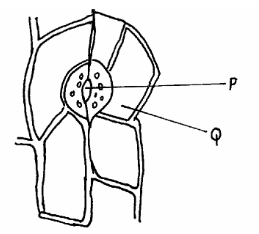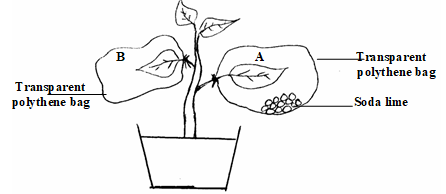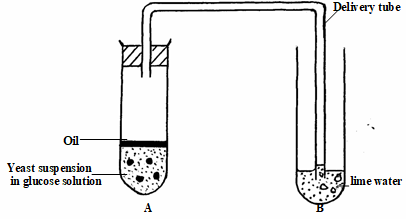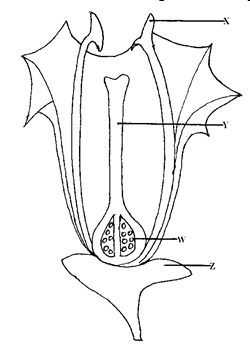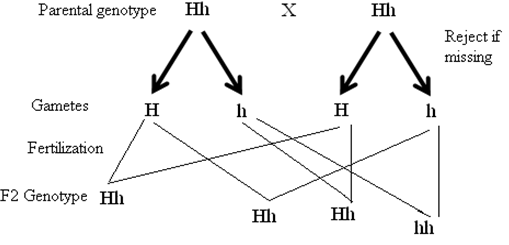INSTRUCTIONS TO CANDIDATES
- This paper has two sections A and B.
- Answer ALL the questions in section A in the spaces provided on the question paper.
- In section B answer question 6(compulsory) and either question 7 or 8.
- The diagram below shows a portion of a lower epidermis of a sukuma wiki leaf.
- Name the parts labeled P and Q. ( 2mks)
- Briefly describe the photosynthetic theory of stomata opening. ( 5mks )
- State one modification in the stomata of xerophyte plant other than being sunken and hairy. ( 1mk)
- The diagram below represents an experimental set-up to investigate an aspect of photosynthesis.
The set up was placed in darkness for 24 hrs and then exposed to light for 5 hrs.- What was the aim of the experiment? (1mark)
- Leaves A and B were tested for starch.
- What would be the expected results? (2marks)
- Give reasons for your answer in (b) (i) above. (2marks)
- What was the role of leaf B in the experiment (1mark)
- Why was the set – up placed in darkness for 24 hours? (1mark)
- Name the organelle in a plant where photosynthesis takes place (1mark)
- The diagram below illustrates an experiment to demonstrate a certain biological process.
Before adding yeast suspension in tube A, the glucose solution was first boiled and cooled.- What biological process was being demonstrated? (1mark)
-
- What observation would be made in tube B after 20 minutes of the experiment? (2marks)
- Account for the observations made in (b) (i) above (2marks)
- Write down an equation to summarize the reaction taking place in tube A. (1mark)
- State two industrial applications of the chemical reaction taking place in tube A. (2marks)
- The diagram below represents a flower.
- Name the parts labeled X and Y. (2mks)
- Describe the ovary position. (1mk)
-
- Suggest an agent of pollination of the flower above (1mk)
- Give a reason for your answer above. (1mk)
- On the diagram above, which part do you expect to find haploid nucleus after meiosis? (1mk)
- In the flower above its sepals cell was found to have 20 chromosomes. What would be the number of chromosomes found in the endosperm cell of the flower embryo sac after fertilization? (1mk)
- State one way in which flowers prevent self – pollination. (1mk)
- When the offspring of purple and white flowered pea plants were crossed, they produced purple and white flowered plants in the ratio of 3: 1
Using letter H to represent the gene for purple colour- State the genotype of:
- Parents ( 2 mks)
- F1 Generation ( 1 mk)
- Work out the cross between plants in the F1 generation ( 4 mks)
- Account for the colour the flowers in plants of the F1 generation ( 1 mk)
- State the genotype of:
SECTION B (40 marks)
Answer question 6 (compulsory) in the space provided and either question 7 or 8 in the spaces provided after question 8.
- In an experiment to investigate the effect of temperature on the activity of salivary amylase enzyme, test tubes containing 5 cm3 of starch solution were placed in water baths maintained at different temperatures. After 30 minutes, 0.1cm3 amylase solution was added into each of the tubes.
At one minute intervals, a drop of the mixture in each tube was tested for presence of starch. The time taken for all the starch to be digested was taken and recorded. The results were as shown in the table below.
Temperature (°c) 5 10 15 20 25 30 35 40 45 Time taken to digest all starch (mins) 80 60 48 26 18 9 3 14 75 - On the grid provided plot a graph of time taken to digest all the starch against temperature. (6 marks)
- What was the optimum temperature range for this enzyme? (1mark)
- Account for the results obtained at
- 5°C (2marks)
- 45°C (2marks)
- Apart from temperature name three other factors that would affect the above reaction.(3marks)
- Name two regions in a human body where digestion of starch occurs. (2marks)
-
- Give three metallic ions that act as enzyme co- factors in a human body. (2marks)
- What is the role played by enzyme co- factors in the physiology of human body? (1mark)
- Name the major respiratory substrate in a mammalian body during severe starvation. (1mark)
- How are leaves of mesophytes suited to their function? (20mks)
- Describe the adaptations of the mammalian skin to its functions. (20mks)

MARKING SCHEME
-
- P- Stomatal pore / opening / aperture; Rj stomata
Q- Epidermal cell; Rj Epidermis. (2mks) - Guard cells have churoplasts hence in the presence of light/ during the day photosynthesis occurs in guard cells; producing sugar in guard cells that increases osmotic pressure; water from epidermal cells enters into guard cells; causing turgidity of cells; the inner walls of the guard cells are thicker than outer walls; hence inner walls stretch more during turgidity; causing guard cells to bulge outer wards; (stomata open)
7mks. Max 5. -
- Reversed rhythm;
- Small stomata / stomatal pore / aperture/ opening;
2marks, max . 1mk
- P- Stomatal pore / opening / aperture; Rj stomata
-
- To investigate if Carbon (IV) Oxide is necessary for photosynthesis; (1mk)
-
- A – No starch; acc Brown colour\
B – Starch present; acc Blue black colour (2mks) - A – Absence of Carbon (IV) Oxide hence no photosynthesis;
B – Carbon (IV)Oxide present , the leaf photosynthesized; (2mks)
- A – No starch; acc Brown colour\
- Control (experiment); (1mk)
- Destarch the leaves /plant; OWTTE (1mk)
- Chloroplast; (1mk)
-
- Anaerobic respiration; (1mk)
-
- Air bubbles; Lime water turns white precipitated; (2mks)
- Yeast cells respired (anaerobically); producing carbon (IV) oxide (2mks)
Glucose → Ethanol + Carbon (IV) Oxide + water
- C6H12O6 → 2C2H5OH + 2CO2 + 210Kj /Energy (1mk)
-
- Manufacture of alcoholic drinks;
- Baking of bread/ raising dough; (2mks)
-
- X- Anther/ male part
Y – Style/ pistil/ female part - Epigyneous / superior flower/ ovary above the other floral parts
-
- Wind Pollinated flower;
- Anthers located above the stigma;
(Rej. Brightly coloured petals/scented/nectarines)
- X/W
- 30 chromosomes;
-
- Anthers located below the stigma;
- self – sterility / incompatibility
- Protandry/ male parts (stamen) maturing earlier than the female parts (pistil)
- Protagyny / female parts (pistil) maturing earlier than the male parts (Stamens);
Any one stated correctly = 1mk
- X- Anther/ male part
-
-
- HH; and hh;
- Hh
-
- The RJ if the information on the left is wrong/ if given, the gene for purple colour is dominant/ gene for white colour is recessive;
-
-
- See graph.
Scale = 2mks
Labeling axes = 2mks
Plot = 1mk
Curve = 1mk - 34°C --37°C; (1mk)
-
- Long time taken (to digest starch); because enzymes were inactivated (by low temperature below optimum); (2mks)
- Long time taken (to digest starch)/75 minutes; enzyme /salivary amylase was denatured/ destroyed (by temperature above optimum); (2mks)
-
- PH;
- Enzyme concentration;
- Substrate concentration;
- Enzyme inhibitors;
- Enzyme specificity;
- Cofactors and coenzymes (3mks)
-
- Mouth
- Duodenum 2mks)
-
-
- Fe/iron;
- magnesium
- Zinc
- Copper
- Activate enzymes; (1mk)
-
- Proteins; (1mk)
- See graph.
-
- Broad / wide / flat lamina; to provide large S.A; for absorption of CO2/sunlight;
- Thin; to ensure short distance for CO2 to reach photosynthetic cells/palisade/mesophyll
- ;Guard cells/ presence of stomata; for efficient diffusion of CO2 into leaf/ oxygen out of leaf/ gaseous exchange/ water vapour/ transpiration;
- Transparent cuticle/epidermal cells; for penetration of light; into palisade cells/ photosynthetic cells.Palisade cells contain many chloroplasts; to trap light (for photosynthesis);
- Chloroplasts have chlorophyll; for trapping light energy;
- Leaves have veins; Xylem to conduct water to photosynthetic cells; and phloem to translocate the photosynthates to other parts of the plant;
- Air spaces in spongy mesophyll; for gases to circulate/diffuse easily/ for CO2 to diffuse into palisade cells;Mosaic arrangement of leaves; enables all leaves to trap sunlight;
- Palisade cells are next to upper epidermis for maximum light absorption (by chloroplasts)
-
- Has nerve endings/ sensory cells; which are sensitive to stimuli/ heat/ cold/ touch/ pain/ pressure;
- Subcutaneous fat/adipose tissue; insulate body against heat loss;
- Sebaceous glands; secrete sebum an oily substance which is water repellant/ prevents drying/ cracking of skin/ keeping skin supple/ sebum is antiseptic which kills micro – organisms entering through the skin;
- Has blood vessel; that supply food/oxygen/ remove excretory products;
- When temperatures are high blood vessels/ arterioles vasodilate to lose heat by convection/ radiation/ vasoconstrict when temperature are low to conserve/ reduce heat loss; (20marks)
Download Biology Paper 2 Questions and Answers - Bungoma Diocese Mock Exams 2021/2022.
Tap Here to Download for 50/-
Get on WhatsApp for 50/-
Why download?
- ✔ To read offline at any time.
- ✔ To Print at your convenience
- ✔ Share Easily with Friends / Students

